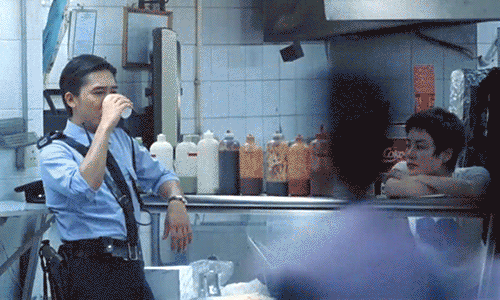TIMESLICE
A Timelapse broken into ‘slices’, creating a different passage of time in each slice. Often creates a gradient-like effect.
FAST MOTION
Also known as undercranking, this technique is created when a scene is purposefully captured at a low frame rate with the intention of it being sped up. Benny Hill should ring a bell.
ARTIST SPOTLIGHT
ARTIST SPOTLIGHT
Fong Qi Wei’s
Time slices
Fong Qi Wei is a Singaporean artist who is known for his creative photography and digital art, including his “Time Slices” series.
In these works, he takes a series of photographs over a period of time, typically from sunrise to sunset or vice versa, and then combines them into a single image. The resulting image shows a compressed timeline of the scene, with the different moments of the day blending seamlessly together.
UNDERCRANKING
Undercranking in film is when you turn the crank slower than usual, making your actors look like they're in a Benny Hill skit.
CHUNGKING EXPRESS, Wong Kar Wai, 1994
CHUNGKING EXPRESS, Wong Kar Wai, 1994
NBA - Playoff Mode (2023)
Sports Direct (2022) Yoni Lappin
Beastie Boys - An Open Letter To NYC
Rob Whitworth - Beyond Traffic
DIVE DEEPER
DIVE DEEPER
Undercranking 101
-
Undercranking and timelapse are two different techniques used in filmmaking to manipulate the passage of time.
Undercranking involves filming a scene at a slower frame rate than the normal 24 frames per second (FPS) to create a sped-up effect when played back at the standard frame rate. For example, filming at 12 FPS and playing back at 24 FPS would result in a 2x faster playback speed, making the action appear more frenetic and energetic.
On the other hand, timelapse involves taking a series of still photographs at a regular interval over a long period of time and then combining them into a video sequence that is played back at a standard frame rate. This technique is often used to show the gradual passage of time, such as the movement of clouds, the growth of plants, or the construction of a building.
While both techniques involve manipulating time, undercranking is more commonly used for dramatic effect or to create a sense of urgency, while timelapse is often used to show the passage of time in a way that is difficult to capture with normal filming techniques.
-
Undercranking, which involves filming at a slower frame rate to create a sped-up effect, is a technique that has been used in filmmaking for over a century. However, it is less commonly used in modern cinema, as digital technology has made it easier to achieve similar effects through post-production manipulation.
That being said, there are still some modern directors who use undercranking in their films. For example, Edgar Wright is known for his use of undercranking in action sequences to create a heightened sense of energy and excitement. His films such as "Scott Pilgrim vs. the World" and "Baby Driver" feature fast-paced action sequences that utilize this technique.
In addition, director Taika Waititi used undercranking in his film "Thor: Ragnarok" to create a humorous and lighthearted tone during a fight scene between Thor and Hulk.
-
Undercranking was first used in the late 19th century, when film cameras were hand-cranked and did not have a set standard frame rate.
During this time, filmmakers discovered that by cranking the camera slower than the standard rate of 16 to 24 frames per second (FPS), they could create a sped-up effect when the film was played back at the normal frame rate. This technique was commonly used in early silent films to create comedic or fantastical effects, such as the appearance of people moving faster than normal or objects flying through the air.
The opposite of undercranking is overcranking, which involves filming at a faster frame rate than normal to create a slow-motion effect when played back at the standard frame rate. Overcranking was also used in early cinema, particularly in action sequences, to create a dramatic effect.
As technology advanced and film cameras became more sophisticated, the use of undercranking and overcranking became less common. However, the basic principles behind these techniques have been carried forward into modern filmmaking, where similar effects can be achieved through digital manipulation during post-production.
-
Undercranking is a filmmaking technique that has been used in movies for over a century. It has been employed in a wide variety of films, from silent comedies to modern action movies. Here are a few examples of movies that use undercranking:
"The Great Train Robbery" (1903) - This classic silent film by Edwin S. Porter is one of the earliest examples of undercranking in cinema. The film uses the technique to create a fast-paced chase scene as the robbers try to escape from the train.
"Modern Times" (1936) - This Charlie Chaplin film features a famous scene in which Chaplin's character works on an assembly line in a factory. The scene uses undercranking to speed up the action and create a sense of chaos.
"The Matrix" (1999) - This sci-fi action film directed by the Wachowski siblings uses undercranking in several fight scenes to create a sense of speed and agility.
"Scott Pilgrim vs. the World" (2010) - This film, directed by Edgar Wright, uses undercranking extensively in its action sequences to create a hyperkinetic, comic book-style effect.
"Baby Driver" (2017) - Another film directed by Edgar Wright, "Baby Driver" uses undercranking in its car chase scenes to create a sense of speed and excitement.
These are just a few examples of movies that use undercranking. The technique has been used in countless other films over the years, and continues to be a useful tool for filmmakers looking to create dynamic, visually striking scenes.
ARTIST SPOTLIGHT
ARTIST SPOTLIGHT
Wong Kar Wai’s
Undercranking
Wong Kar Wai is a renowned filmmaker from Hong Kong known for his unique and visually stunning movies that often explore themes of love, loss, and the human condition. He has won numerous awards and has been recognized as one of the most influential filmmakers of his generation.
Wong Kar Wai's films often feature undercranking techniques to create a sense of urgency and excitement, particularly in scenes featuring crowds or cityscapes.
In films like "Chungking Express" and "Fallen Angels," Wong Kar Wai uses undercranking to create a frenetic, almost chaotic energy in these scenes, conveying the bustle and energy of the city.























































